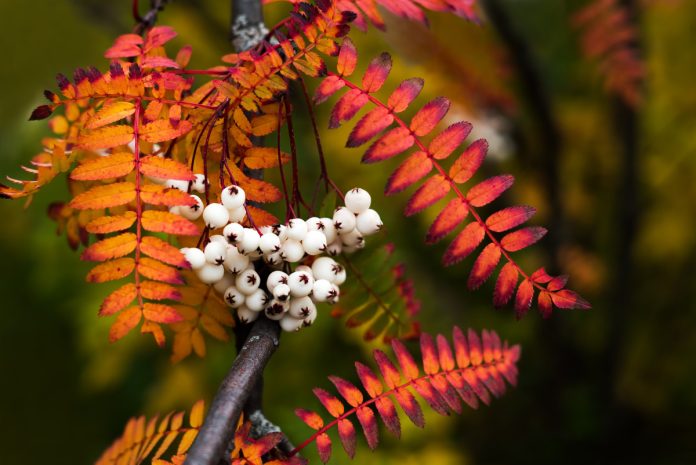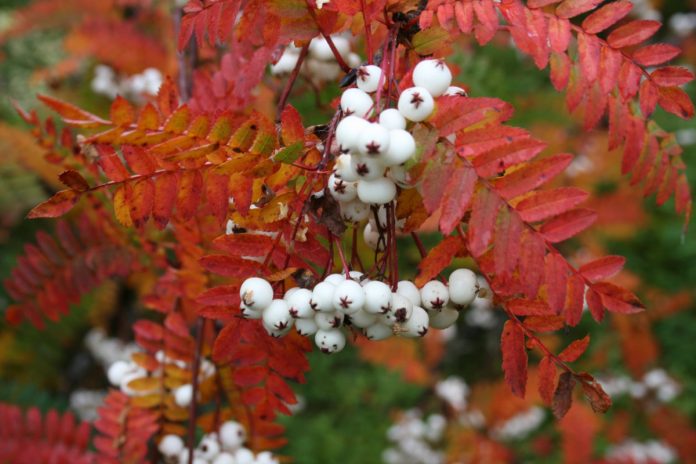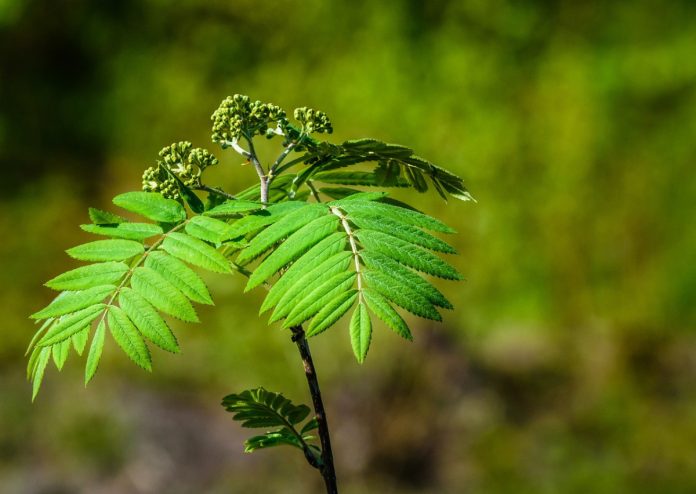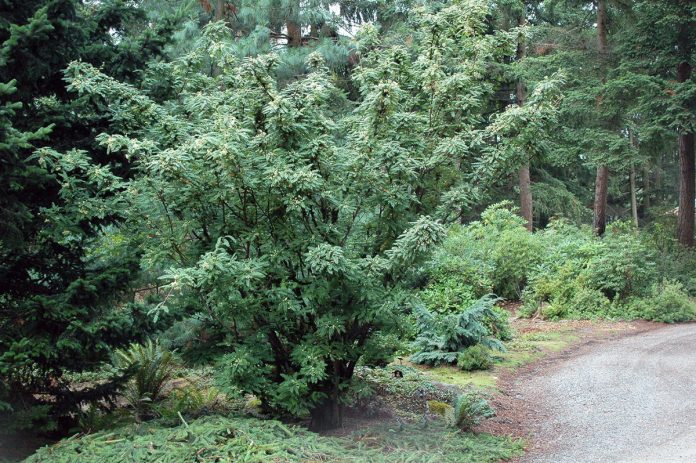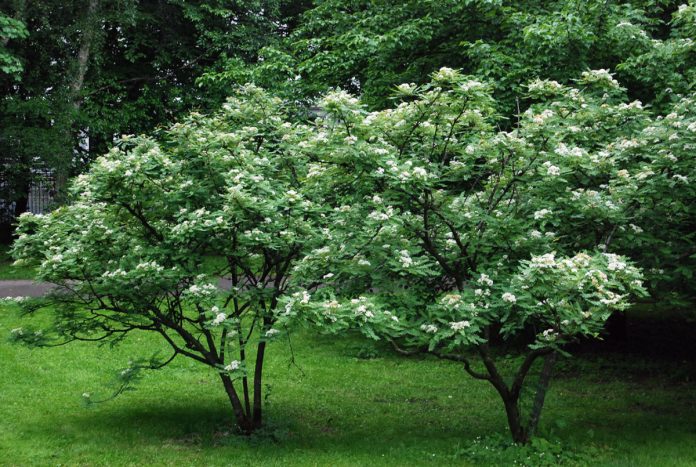The Latin name for rowan is “Sorbus” and if go back to the Indo-European “a tree with dark or red fruits”.
All rowan trees can be divided into two large groups :
- Eu-Sorbus (plants with odd-pinnate compound leaves like the familiar mountain ash);
- Hahnia (rowans with simple whole or lobed leaves).
White-fruited rowan trees are included in the first group. These are Kashmiri rowan, Pratt, small-leaved, Vilmorena, ivory, and many others. A distinctive feature of white-fruited mountain ash is its very lacy long leaves with a large number of narrow small leaves extending from the main petiole. Our heroine today, the Koehne rowan, also belongs to such rowan trees.
What is Koehne Rowan?
In nature, Koehne’s mountain ash (Sorbus koehneana/frutescens) is found in mixed and deciduous forests of mountainous China and East Asia, climbing to a height of 2000-4000 m above sea level. In its homeland, it is a tree or shrub up to 5 m high, sometimes higher, with a pyramidal crown and shoots growing at an acute upward angle. Over time, they droop and form something like a fountain or umbrella.
In the middle zone, the size of an adult plant does not exceed 3×3 m, usually less. For decorative purposes, Koehne rowan is often grown on a trunk and grafted onto more resistant species such as rowan. In this case, the final dimensions depend on the height of the grafting, and the shape and density of the crown depend on the forming pruning.
Like all rowan trees of the Eu-Sorbus group, the leaves of the Koehne rowan are long (up to 20 cm) and complex (from 17 to 33 narrow oval leaves with a finely toothed edge are attached to the central “axis”). Moreover, most of the leaves are located at the ends of the shoots, which is why the crown looks especially openwork. In June, the tree is covered with white shields of inflorescences with a diameter of about 10 cm. The smell of rowan, as they say, is not for everyone, which does not prevent it from being an excellent honey plant.
But all the beauty of the Koehne rowan tree is revealed in the fall when the foliage blazes with all shades of orange, red, and purple, and against its background the snow-white, porcelain-like clusters of berries on raspberry stalks look especially decorative. The rowan fruit is not a berry, but the most classic apple, like all apple trees. The fruits are edible, but sour and bitter.
They ripen in August-September and stay on the branches all winter: practice shows that birds that happily feast on red and orange fruits for some reason do not touch white ones.
How to grow a healthy and beautiful tree
About sun and warmth
Rowan Koehne prefers a sunny place but is quite tolerant of light shade. With a lack of lighting, the crown becomes more sparse. The ideal place is the south, southwest, or southeast side of the garden, protected from the winds. In an area with an elevation difference, you can plant Koehne rowan at the top of the slope, where it will be well-lit and protected at the same time.
In addition to the calm zone, it is advisable to provide young seedlings with shelter in the first years. Subsequently, the plant becomes quite stable; only in particularly harsh winters with prolonged severe frosts can the ends of the shoots freeze. Often “losses” occur not at all due to insufficient winter hardiness, but due to rejection from the rootstock. Our rowan grows slowly (about 20 cm per year), so you will have to be patient.
What soil to plant in and how to do it correctly
Rowan Koehne needs fertile soil with a slightly acidic or neutral reaction. It is important that the soil is loose and moderately moist because Koehne mountain ash suffers from overcompaction, excessive dryness, and humidity. Also does not like excessive salinity. But in conditions of urban pollution, Koehne rowan grows well.
Standard planting rules :
- plants with a closed root system are planted at any time from spring to autumn;
- seedlings with an open root – in the spring before buds open or in the fall from the beginning of mass leaf fall until the end of October.
But, of course, you should not plant rowan on too hot sunny days. The ideal time is a cloudy day in the fall, but at least 1 month before the soil freezes so that the plant has time to take root.
Rowan trees have a branched, fibrous root system that lies shallow. As a rule, it is enough to dig a planting hole of 0.5×0.5×0.5 m, but you need to focus primarily on the volume of the root of a particular seedling. In the case of the Closed root system (CRS), it is necessary to provide a distance of 20 cm from the edges; in the case of the open root system (ORS), the straightened roots should not rest against the walls of the pit.
First, the top fertile humus layer is removed (we fill it back at the end). The remaining soil is either completely replaced with fertile substrate or in a 1:1 ratio. We lay 10-20 cm of drainage layer on the bottom. This measure is mandatory on heavy, wet soils, especially in areas located in lowlands, because the Koehne mountain ash does not like excessive waterlogging. In this case, the depth of the hole increases accordingly. Expanded clay, crushed stone, broken brick or sand can be used as drainage. Further steps vary depending on whether the seedling has a closed or open root system.
With CRS :
- On top of the drainage layer, pour 1/3 of the fertile soil to the bottom. Fill it with water and mix the mud, to which you can add a root growth stimulator.
- We place the seedling in the mud, cover it with the remaining soil, return the humus layer, and compact it.
- The root collar should be above the soil level (so that when the water goes away and the soil subsides, it will be level or slightly above the ground);
- We build a watering roller 10 cm high along the perimeter of the hole and water the plant.
With ORS :
- We install a garter peg in the hole.
- At the bottom of the planting hole, on top of the drainage, pour a dense cone of fertile soil mixed with fertilizers (according to the season). The height of the cone should be such that the root collar rises approximately 10 cm above the soil level.
- Place the seedling on the top of the cone and straighten the roots.
- We fill in the fertile soil, shaking the plant periodically so that no voids form between the roots, and at the end – a humus layer.
- We compact the soil from the periphery to the center.
- We build a watering roller and water.
If desired, spray with Zircon or Epin. The tree trunk circle can be mulched with compost, sawdust, peat, etc. In the case when planting is planned in the spring, the planting hole is prepared in advance, in the fall, and insulated with leaves, sawdust or straw.
Easy care
Rowan Koehne is quite unpretentious and, if planted correctly, does not cause much trouble. In very hot, dry summers, additional watering is required 1-2 times a week. In the first years, for the winter, you need to build an air shelter from non-woven material, and additionally mulch the tree trunk circle.
Rowan Koehne is moderately demanding in terms of fertility, so no special fertilizing is needed. You can limit yourself to nitrogen, phosphorus and potassium in spring and summer, and after August 15 – only potassium and phosphorus fertilizers: they will help the plant survive the winter better. Diseases and pests rarely attack Koehne rowan, so preventive measures are not necessary, and when problems arise, standard fungicides and insecticides are used.
Formative and sanitary pruning is carried out in the spring as early as possible, since rowan trees begin to grow early. Cut out broken, frozen, diseased and dry branches, as well as those growing inside the bush. Intertwining and rubbing shoots are cut into a ring, leaving crowns that are more viable and directed toward the periphery. To stimulate branching, more radical shortening pruning is used, but in the current season this will affect flowering and fruiting.
Reproduction
There are several proven methods here. Firstly, you can propagate Koehne rowan using summer cuttings. Green cuttings take root well, and for the success of this undertaking, only two compound leaves are left on the cutting.
The second option is budding or grafting onto a mountain ash or another rootstock. When budding, one dormant bud is grafted; when grafting, a shoot is grafted. The “operation” is performed on the root collar or on the stem of the rootstock at a certain height – to obtain a standard weeping form. These manipulations are carried out in July-August. The grafting site is wrapped in breathable material or coated with garden pitch; the material is removed after about 4 weeks. Next spring, when the grafted bud/shoot begins to grow, the stem of the rootstock above the grafting site is cut off.
And the third way is with seeds. However, in this case, the resulting seedlings are not always uniform in quality. When planting in the fall, freshly collected unripe seeds are used, and the seedlings must be mulched. Rowan should be sown in early autumn so that the seeds have time to undergo natural stratification and germinate successfully the next year. When planting in spring, preliminary artificial stratification is required: prepared dried (but not overdried!) seeds are placed in a moist aerated substrate at low temperatures for 3-4 months.
Using Koehne rowan in landscape design
Rowan Koehne is a compact plant, therefore it is suitable even for a small garden or a bright courtyard, and there are many options for use.
In a solitary planting
Thanks to its graceful crown, lacy foliage and decorative fruits, the Koehne rowan tree looks great when planted alone in the center of a lawn or lawn. Moreover, both a free-growing unformed tree/shrub and standard forms look equally advantageous.
In tree and shrub mixborders
Köhne rowan visually and according to agrotechnical requirements combines very well with many ornamental shrubs (Thunberg barberry, brilliant cotoneaster, spirea, etc.) and will fit well into a medium-sized composition. Plant the plant in the middle or background of the mixborder. In the summer, its small lacy leaves serve as an excellent backdrop for beautifully flowering and variegated shrubs and perennials, and in the fall it itself becomes a bright accent.
In compositions with conifers
Our rowan will look especially advantageous in the autumn, when the bright foliage makes it stand out against the backdrop of evergreen conifers, and in the winter, when the needles set off the snow-white clusters. Rowan may be the only colored plant in the composition, but a mixborder looks more harmonious, in which the color spots are evenly distributed over the area. To do this, you can plant several rowan seedlings or add similar colors with other deciduous ones, the same spirea.
In compositions with stone
All the decorativeness of foliage (both green and colored) is most easily appreciated against some neutral natural background. For example, on natural gray or brown. In addition, the compactness of the root system allows you to grow Koehne rowan on alpine hills.
In tubs
The small size of the tree itself and its root system makes it possible to use Koehne rowan as a container crop, decorating small courtyards, patios, and terraces.
In a private seating
A living, untrimmed Koehne rowan hedge looks very picturesque. Moreover, the plant is not afraid of gas pollution and smoke, so such a row planting can be organized even near a parking space. Planted along the perimeter of the site, Koehne’s rowan will be an excellent background for other plants, and thanks to the fine texture of the foliage, it will visually expand the space (although less noticeable than plants with blue foliage/needles).
For a collection garden
As already noted, the species diversity of rowan trees is so great that at first glance one may not understand that this is a rowan tree. For example, the rowan aria has simple, rounded leaves with white-tomentose pubescence. And the leaves of the intermediate rowan are similar to the leaves of the common hawthorn. In addition, many hybrid varieties have been bred in a variety of shapes and sizes, with fruits not only red or orange, but also yellow, pink and brown, differing in size and taste. A collection of rowan trees can become a real calling card of your site, and the Koehne white-fruited rowan will take its rightful place in it.
A little “mysticism” at last
Rowan has long been considered a magical plant, with which different peoples have many beliefs and rituals. Its security function remained unchanged. Rowan trees were traditionally planted near the house to ward off evil spirits, and in England it was believed that rowan trees ward off lightning. The ancient Celts made protective amulets from rowan wood or carved protective signs into the bark of the tree. The protective abilities of the mountain ash extended to newlyweds, and also protected sailors who went out to sea to fish from sorcerers.
The rowan fruit, like any apple, in cross section gives a pentagram – a powerful protective symbol. For protection purposes, bunches of rowan berries were hung at the entrance to the house, and rowan branches were stuck along the perimeter of the cultivated field. In Rus’, this ritual was performed at the end of September on the day of Peter and Paul the Fieldfare, in Germany – on Walpurgis Night.
True, the rowan was not only a talisman, but also a symbol of grief. Its bowed branches symbolized a grief-stricken woman, and its clusters (mostly red) symbolized her tears, so rowan was often planted over graves.
In Christianity, rowan is an attribute of the Virgin Mary and St. Luke. In Rus’ they believed that rowan brings good luck, happiness, peace and order to the home and family. In Ireland there is an expression associated with the rowan tree: “To follow the branch of knowledge.” It means “to do whatever it takes to gain knowledge/information” and dates back to the ancient Celtic custom of summoning and questioning demons in a circle lined with ox hides and enclosed by a rowan hedge. In addition, the Celts associated rowan with the two runes Nautiz and Algiz and believed that the “presence” of rowan increased the success of predictions. The Scandinavians gave the rowan magical powers when searching for treasures: it was believed that the sprouts of rowan trees grown on other trees, in hollows and on stumps could help with this.

